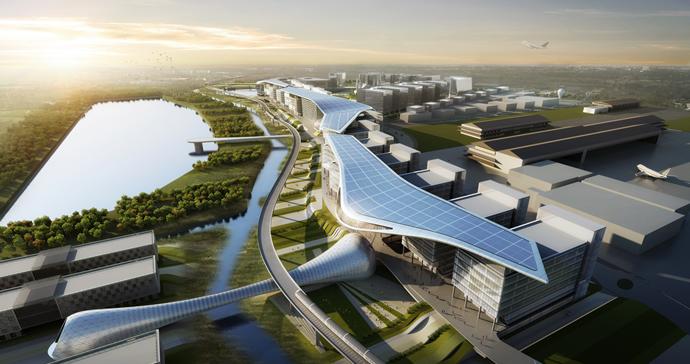TThe University of Nottingham is lending its engineering expertise to an ambitious new aerospace center in Malaysia, according to a July 2014 release from the university. Asia Aerospace City brings together University research with the Aerospace Malaysian Innovation Centre (AMIC) and MARA Aerospace & Technologies (M-AeroTech), a Malaysian government agency.
Kuala Lumpur-based Asia Aerospace City was officially launched at the 2014 Farnborough International Airshow, one of the world’s largest aerospace exhibitions and air displays. The University signed a Memorandum of Understanding with AMIC and MARA.
The partners will collaborate on research and technology, specifically on virtual reality, tooling supply chain development, repair and composite manufacturing.
The University of Nottingham Malaysia Campus will be contributing to this important AMIC initiative through research and development in the focal areas of composite manufacturing, tooling and manufacturing automation.
Professor Andrew Chan is the academic lead on the project from The University of Nottingham Malaysia Campus (UNMC).
“This is a major milestone in the research profile of UNMC and a true recognition of our research capabilities in aerospace engineering,” noted Professor Chan, Associate Dean, Engineering. “We are truly honored to be entrusted with this opportunity by the Malaysian Government, and we shall be doing our best in our contribution towards the aerospace industry developments in Malaysia.” The Memorandum of Understanding was witnessed by Professor Hai-Sui Yu, Pro-Vice Chancellor, Internationalisation, The University Nottingham, several Malaysian aerospace industry executives and Tan Sri Amir Sham, Chairman of the Malaysian Investment Development Authority.
Asia Aerospace City’s Executive Director, En. Zulfikri Osman, said: “Asia Aerospace City is a complete business ecosystem, a synergy of human capital capabilities, excellent engineering services supported by a strong innovation culture. It transcends the current aerospace value chain proposition of various infrastructural models around Asia, towards a knowledge-based, highly trained services capability business, which serves as the nucleus for the future developments in aerospace industry globally. That is why our investment focuses on people too, not just technology and infrastructure, in positioning AAC as the aerospace hub in Asia.”
AMIC is funded by the Malaysian Government, Airbus, Rolls Royce and Composites Technology Research Malaysia (CTRM).
Project design reflects national vision
Atkins, the lead consultant and master planner for Asia Aerospace City (AAC) in Subang, Malaysia, completed the concept design and master plan for the development in 2014. The AAC has been designed as a smart city with cutting edge research and development facilities, integrated office suites, academic campuses, a convention center and residential areas.
“This is an important project for Malaysia’s Economic Transformation Plan, and Atkins is honored to be working with MARA to deliver an outstanding academic and industry facility for the aerospace sector,” said Chris Birdsong, Atkins’ CEO for Asia Pacific. We believe that it will play an important role in achieving the national vision of a self-sufficient, industrialized Malaysia by 2020.”
Rural and regional development minister, Datuk Seri Mohd Shafie Apdal, added that the development will draw interest and commitment from international aerospace industry players to enable Malaysia to become the aerospace hub in Asia.
Inspiration for the 328,000-sq.-m. (3.5-million-sq.-ft.) AAC design came from the wings of an airplane. With interaction between students and engineers identified by MARA as a key objective, the buildings are arranged to create nodes for various types of activities:
- An academic cluster which includes the Malaysian Institute of Aviation Technology and a professional development center for about 2,000 students;
- A research and training center supporting aerospace testing and validation activities;
- A central cluster for professional event functions, with a convention center and a business hotel; and
- Restaurant, cafe and sports facilities which will extend social interaction for resident engineers and students and visitors.
Computational Fluid Dynamics (CFD) analysis was used by Atkins to align buildings and allow natural breezes through the outdoor areas. A set of canopies covering 36,000 sq. m. (387,000 sq. ft.) will shade outdoor areas and contribute to on-site energy generation through in-built photovoltaic panels.
A light railway station is being built within walking distance of the AAC connecting it to the center of Kuala Lumpur and to nearby Subang Airport, which caters for regional and domestic flights. In addition electric buses will serve the AAC and adjacent commercial and light industrial facilities. The campus itself will be a completely pedestrianized.
